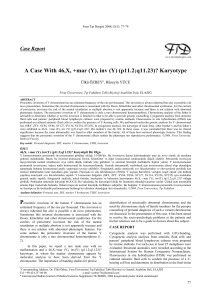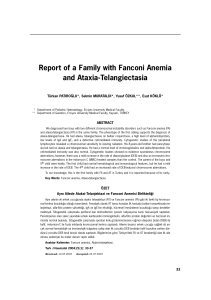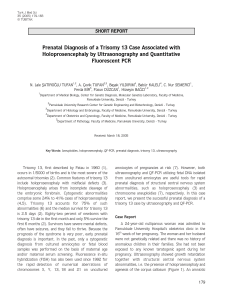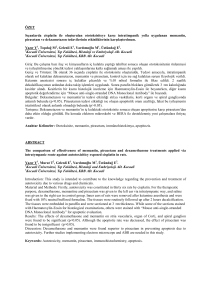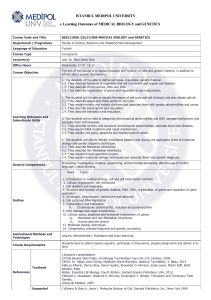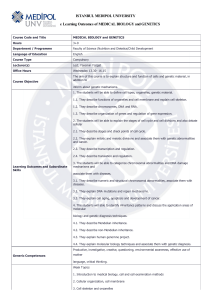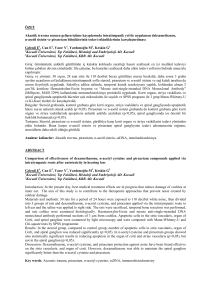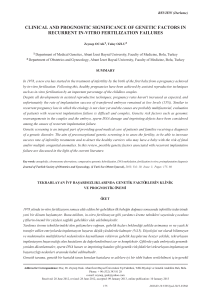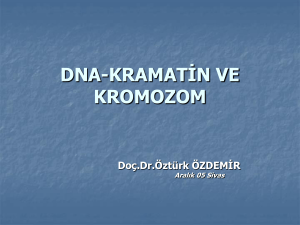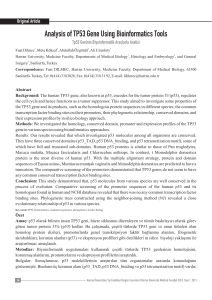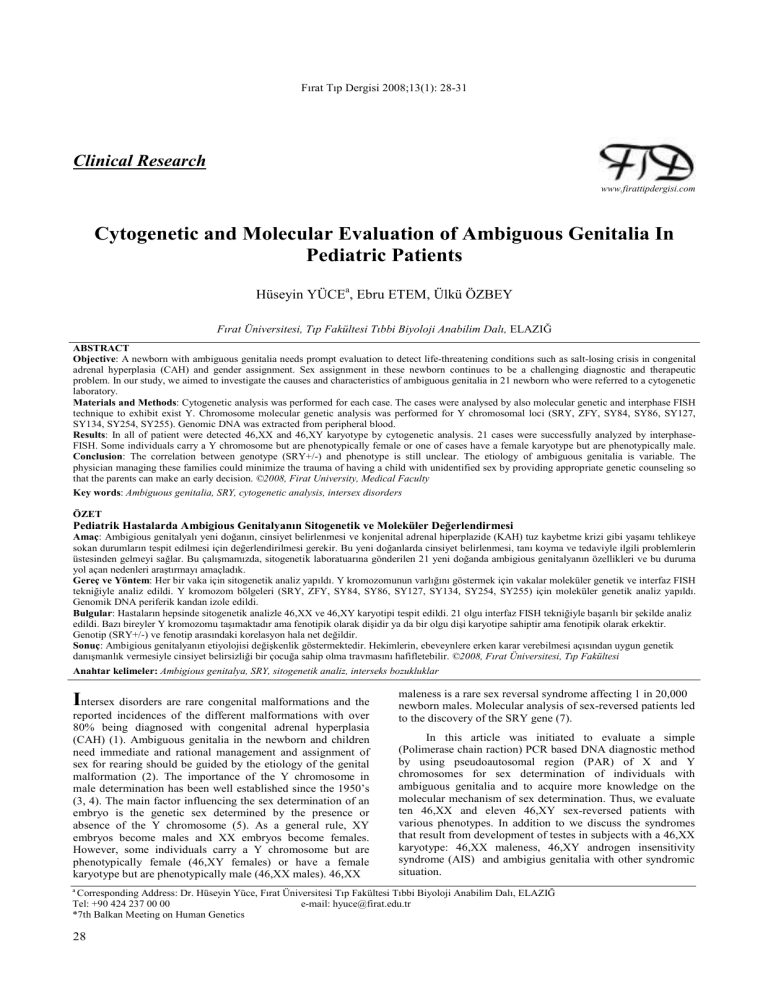
Fırat Tıp Dergisi 2008;13(1): 28-31
Clinical Research
www.firattipdergisi.com
Cytogenetic and Molecular Evaluation of Ambiguous Genitalia In
Pediatric Patients
Hüseyin YÜCEa, Ebru ETEM, Ülkü ÖZBEY
Fırat Üniversitesi, Tıp Fakültesi Tıbbi Biyoloji Anabilim Dalı, ELAZIĞ
ABSTRACT
Objective: A newborn with ambiguous genitalia needs prompt evaluation to detect life-threatening conditions such as salt-losing crisis in congenital
adrenal hyperplasia (CAH) and gender assignment. Sex assignment in these newborn continues to be a challenging diagnostic and therapeutic
problem. In our study, we aimed to investigate the causes and characteristics of ambiguous genitalia in 21 newborn who were referred to a cytogenetic
laboratory.
Materials and Methods: Cytogenetic analysis was performed for each case. The cases were analysed by also molecular genetic and interphase FISH
technique to exhibit exist Y. Chromosome molecular genetic analysis was performed for Y chromosomal loci (SRY, ZFY, SY84, SY86, SY127,
SY134, SY254, SY255). Genomic DNA was extracted from peripheral blood.
Results: In all of patient were detected 46,XX and 46,XY karyotype by cytogenetic analysis. 21 cases were successfully analyzed by interphaseFISH. Some individuals carry a Y chromosome but are phenotypically female or one of cases have a female karyotype but are phenotypically male.
Conclusion: The correlation between genotype (SRY+/-) and phenotype is still unclear. The etiology of ambiguous genitalia is variable. The
physician managing these families could minimize the trauma of having a child with unidentified sex by providing appropriate genetic counseling so
that the parents can make an early decision. ©2008, Firat University, Medical Faculty
Key words: Ambiguous genitalia, SRY, cytogenetic analysis, intersex disorders
ÖZET
Pediatrik Hastalarda Ambigious Genitalyanın Sitogenetik ve Moleküler Değerlendirmesi
Amaç: Ambigious genitalyalı yeni doğanın, cinsiyet belirlenmesi ve konjenital adrenal hiperplazide (KAH) tuz kaybetme krizi gibi yaşamı tehlikeye
sokan durumların tespit edilmesi için değerlendirilmesi gerekir. Bu yeni doğanlarda cinsiyet belirlenmesi, tanı koyma ve tedaviyle ilgili problemlerin
üstesinden gelmeyi sağlar. Bu çalışmamızda, sitogenetik laboratuarına gönderilen 21 yeni doğanda ambigious genitalyanın özellikleri ve bu duruma
yol açan nedenleri araştırmayı amaçladık.
Gereç ve Yöntem: Her bir vaka için sitogenetik analiz yapıldı. Y kromozomunun varlığını göstermek için vakalar moleküler genetik ve interfaz FISH
tekniğiyle analiz edildi. Y kromozom bölgeleri (SRY, ZFY, SY84, SY86, SY127, SY134, SY254, SY255) için moleküler genetik analiz yapıldı.
Genomik DNA periferik kandan izole edildi.
Bulgular: Hastaların hepsinde sitogenetik analizle 46,XX ve 46,XY karyotipi tespit edildi. 21 olgu interfaz FISH tekniğiyle başarılı bir şekilde analiz
edildi. Bazı bireyler Y kromozomu taşımaktadır ama fenotipik olarak dişidir ya da bir olgu dişi karyotipe sahiptir ama fenotipik olarak erkektir.
Genotip (SRY+/-) ve fenotip arasındaki korelasyon hala net değildir.
Sonuç: Ambigious genitalyanın etiyolojisi değişkenlik göstermektedir. Hekimlerin, ebeveynlere erken karar verebilmesi açısından uygun genetik
danışmanlık vermesiyle cinsiyet belirsizliği bir çocuğa sahip olma travmasını hafifletebilir. ©2008, Fırat Üniversitesi, Tıp Fakültesi
Anahtar kelimeler: Ambigious genitalya, SRY, sitogenetik analiz, interseks bozukluklar
Intersex disorders are rare congenital malformations and the
reported incidences of the different malformations with over
80% being diagnosed with congenital adrenal hyperplasia
(CAH) (1). Ambiguous genitalia in the newborn and children
need immediate and rational management and assignment of
sex for rearing should be guided by the etiology of the genital
malformation (2). The importance of the Y chromosome in
male determination has been well established since the 1950’s
(3, 4). The main factor influencing the sex determination of an
embryo is the genetic sex determined by the presence or
absence of the Y chromosome (5). As a general rule, XY
embryos become males and XX embryos become females.
However, some individuals carry a Y chromosome but are
phenotypically female (46,XY females) or have a female
karyotype but are phenotypically male (46,XX males). 46,XX
a
maleness is a rare sex reversal syndrome affecting 1 in 20,000
newborn males. Molecular analysis of sex-reversed patients led
to the discovery of the SRY gene (7).
In this article was initiated to evaluate a simple
(Polimerase chain raction) PCR based DNA diagnostic method
by using pseudoautosomal region (PAR) of X and Y
chromosomes for sex determination of individuals with
ambiguous genitalia and to acquire more knowledge on the
molecular mechanism of sex determination. Thus, we evaluate
ten 46,XX and eleven 46,XY sex-reversed patients with
various phenotypes. In addition to we discuss the syndromes
that result from development of testes in subjects with a 46,XX
karyotype: 46,XX maleness, 46,XY androgen insensitivity
syndrome (AIS) and ambigius genitalia with other syndromic
situation.
Corresponding Address: Dr. Hüseyin Yüce, Fırat Üniversitesi Tıp Fakültesi Tıbbi Biyoloji Anabilim Dalı, ELAZIĞ
Tel: +90 424 237 00 00
e-mail: [email protected]
*7th Balkan Meeting on Human Genetics
28
Fırat Tıp Dergisi 2008;13(1): 28-31
Özbey ve Ark
MATERIAL AND METHODS
Cases were identified from searching databases held in the
department of medical Biology and Genetic of the Firat
Medical Center, Elazig, during the study period, from 1998 to
2006. Twenty-one patients were seen in the neonatal period.
All children, who were either born with ambiguous genitalia at
the Firat Medical Center, Elazig or were referred from other
hospitals for investigation were included in this study. We
studied the causes and characteristics of ambiguous genitalia in
21 newborn who were referred to a cytogenetic laboratory in
our depatment. All had chromosomal analyses. Karyotyping
was performed in 50 metaphases by conventional and G
banding techniques. The cases were analysed by also
interphase FISH technique using dual prob (Vysis, Ullinois,
USA) to exhibit exist Y chromosome. Hybridization was
performed in according to the manufacturer’s instructions.
Dual-labeling hybridization was performed using 10µl of the
hybridization mixture containing fluorescein direct labeled
chromosome Y alpha-satellite probe and rhodamine directlabelled SRY gene probe. Genomic DNA was extracted from
peripheral leukocytes collected from a venous blood sample.
Genomic DNA was extracted by standard methods from
peripheral blood of all patients (6). DNA was amplified by
PCR using oligonucleotide primers (X specific primer 5’-CTG
CAG AAA CAA GCT CAT CAG CGT GAC TAT-3’, Y
specific primer 5’-GTA CTA CCT TTA GAA AAC TAG TAT
TTT CCC-3’ ve both of X ve Y specific 5’-GAA TTC TTA
ACA GGA CCC ATT TAG-3’ and 5’-GAA TTC TTA ACA
GGA CCC ATT TAG GAAT TAA-3). The DNA was
amplified for 30 cycles with denaturation at 94°C for 5 min, at
94°C for 1 min, at 54°C 1 min, at 72°C for 2 min and extension
at 72°C for 6 min using a eppendorf thermal cycler. The PCR
products were separated by electrophoresis on 2% per cent
agarose gel containing ethidium bromide and photographed
using Gel Doc system (Hero Lab, Germany). Product was
obtained 771 bp for X and 947 bp for Y. DNA obtained from a
men with 46,XY karyotype was used as control. Molecular
analysis of sex-reversed patients led to the discovery of the
SRY gene. We performed molecular genetic analysis for Y
chromosomal loci (SRY, ZFY, SY84, SY86, SY127, SY134,
SY254, SY255) blood leukocytes with Y Chromosoma
Deletion Kit (Dr.Zeydanlı Life Science, Ankara, Turkey).
males usually have genital ambiguity. A small number of SRY
positive XX males also present with ambiguous genitalia. We
obtained 771 bp product for eight patients with 46,XX
karyotype, 771 bp and 947 bp products for thirteen patients
with 46,XY karyotype. One syndromic children were
diagnosed with Edward’s Syndrome. It was obtained 648 bp
for SRY product. Case 6 was not determined examinated other
Y chromosomal sequences (Figure 2). This case was sporadic.
We weren’t found other Y chromosomal sequences in patient
with 46,XX karyotype.
Figure 1. The existence of SRY gene was determined by
interphase FISH
RESULTS
All patients presented 46,XX and 46,XY karyotype at
cytogenetic analysis. Clinical and cytogenetic findings of the
patients are shown in Table1. In eight (38%) of cases have a
46,XX karyotype and eleven (62%) have a 46,XY or Ycontaining karyotype (46,XX). Eight patients with 46,XX
karyotype were detected CAH (38%). Three patients with
female phenotype and 46,XY karyotype were founded AIS
(14.2%). 46,XX maleness were defined 4.7 % of all patients.
One syndromic children was diagnosed with Edward’s
Syndrome.
Figure 2. Result of PCR using SRY specific primers. Lane 1:
Gene Ruler100 bp DNA ladder plus (Fermentas, USA); lane 2:
health males control, lane 3, lane 4, lane 5: SRY negative lanes
6; SRY positive for case 6.
Total of 21 cases were successfully analyzed by
interphase-FISH. Some individuals (cases 1, 11, 21) carry a Y
chromosome but are phenotypically female or one of cases
(cases 6) have a female karyotype but are phenotypically male.
It was detected SRYgene and centromeric signals in patients
with 46,XX karyotype (Figure 1). The presence of SRY causes
the bipotential gonad to develop into a testis. SRY-positive XX
males have normal genitalia; in contrast SRY-negative XX
29
Fırat Tıp Dergisi 2008;13(1): 28-31
Özbey ve Ark
Table 1. Clinical and cytogenetic findings of the patients.
Case
1
2
3
4
5
6
7
8
9
10
11
12
13
14
15
16
17
18
19
20
21
Age(Day)
25
10
8
2
3
18
7
10
5
2
1
8
9
28
7
15
3
19
6
8
12
Social sex
F
F
F
M
M
M
M
M
F
M
F
F
M
M
M
F
F
F
M
M
F
External Genitalia
Ambiguous
Ambiguous
Ambiguous
Ambiguous
Ambiguous
Ambiguous
Ambiguous
Ambiguous
Ambiguous
Ambiguous
Ambiguous
Ambiguous
Ambiguous
Ambiguous
Ambiguous
Ambiguous
Ambiguous
Ambiguous
Ambiguous
Ambiguous
Ambiguous
SRY
+
+
+
+
+
+
+
+
+
+
+
+
+
+
Cytogenetic Diagnosis
46,XY (ADS)
46,XX
46,XX
46,XY
46,XY
46,XX
46,XY
46,XY
46,XX
46,XY
46,XY (ADS)
46,XX
46,XY
46,XY
46,XY
46,XX
46,XX
47,XX,+18
46,XY
46,XY
46,XY(ADS)
DISCUSSION
Human sexual differentiation is a highly complex process
under the control of multiple genes and hormones.
Abnormalities in normal sexual differentiation are relatively
common and occur in approximately 1 per 4500 live births (8).
Human males with a 46,XX karyotype were first described in
1964 by three different groups of investigators (9, 10). The
frequency of this syndrome has been estimated to be 1 in
20,000-25,000 newborn males, although there are considerable
geographic variations (11). Molecular analyses have
demonstrated that approximately 90% of patients with 46,XX
karyotype carry a variable amount of Y material due to a Y-toX interchange originated by an illegitimate recombination
during paternal meiosis (12). In 1999, Kusz et al. demonstrated
that in XX males with Y-to-X translocations, preferential
inactivation of the Y-bearing X chromosome could be the
major mechanism causing a sexually ambiguous phenotype
(13). The origin of male phenotype in XX males could be the
result of at least three different mechanisms: 1) translocation of
Y sequences, including the SRY gene, to an X chromosome or
to an autosome; 2) a mutation in a yet unknown X-linked or
autosomal gene in the testis-determining pathway, and 3)
cryptic Y chromosome mosaicism (14). XX males can be
classified as Y-positive or Y-negative depending on the
presence or absence of Y-derived specific sequences. Most
46,XX males fail to undergo normal pubertal development;
axillary and body hair are generally scant, while pubic hair
shows a female pattern of distribution. Gynecomastia occurs in
approximately one third of cases and lack of spermatogenesis
is always present. External genitalia are underdeveloped and
the presence of small testes is a distinctive trait of the
syndrome (11). In approximately 15% of XX males
hypospadias, cryptorchidism, or severe genital ambiguity is
observed (15). We detect presence of SRY gene in our patient
(case 6) with male phenotype and 46,XX karyotype. It is a
possible mechanism that this patient carry SRY gene due to X
to Y translocation. Although it is now clear that the SRY gene
30
plays a central role in triggering the formation of the testis
from undifferentiated gonad, it has been suggested that other
genes located either on the X or autosome may be involved in
testicular differentiation (16,17).
There was no report of Y specific SRY sequence in
female pseudohermaphrodites. We not detected Y chromosomal sequences in female hermaphrodites with 46,XX
karyotype and ambiguous genitalia. Our study consistent with
previous studies.
Al Agha were determined five syndromic child with
ambigious genitalia. These were: Cardiogenital syndrome (2
cases); Denys–Drash syndrome (1 case); Miller-Dieker
syndrome (1 case); and Klinefelter syndrome (1 case) (2). Of
all 51 children, 12 (23.5%) had no definite final diagnoses (8).
We determined one syndromic patient with ambigious genitalia
and 47,XX,+18. These patients is determined syndromic cases.
Incomplete forms of AIS (PAIS) on the other hand rather
present with an incomplete masculinization than a female
phenotype and can have a varying range of internal male
structures. Frequent features include phenotypic males with a
penoscrotal hypospadias, often containing small testes.
Additionally a small, blind-ending vaginal pouch without
evidence of other female structures can be found. The clinical
manifestation of all CAH forms is characterized by the
virilization of the outer genitalia. It can be mild with a clitoral
hypertrophy or a fusion of the posterior labial folds only, but
also as severe as a male phenotype with bilateral undescended
testes. On further examination, all patients with a regular
karyotype of 46,XX have regular ovaries, Mullerian structures
and regressed Mullerian duct syndrome, Wolfman ducts, since
the missing SRY prevented the development of Sertoli cells
and MIS, respectively (1). Our patients with AIS detected
complete AIS syndrome phenotype and 14.3% incidence in all
patients. Al Agha were determined 17.2% of ambigious
patients (8).
Fırat Tıp Dergisi 2008;13(1): 28-31
The birth of a newborn with ambiguous genitalia
frequently comes as a surprise for the parents, therapist.
Although some authors report that 60% of affected children are
diagnosed prenatally, many parents are faced with the situation
at birth (1). Physical examination is key to diagnosis. Careful
palpation to locate gonads at the genital folds or in the inguinal
region provides the first element for diagnostic orientation. If
gonads are absent, a diagnosis of female pseudohermaphroditism seems advisable; if gonads are palpated, a diagnosis
of male pseudohermaphroditism is more appropriate.
Karyotyping is systematic while PCR analysis of the SRY gene
provides information about the presence of a Y chromosome
within 1 day (2). However, PCR based sex determination is
rapid, reliable and economic and provides an accurate means of
determining sex of an individual, including the detection of
hidden Y sequence (18,19). The presence of a translocation of
chromosomal material encoding the TDF from Y to X
chromosome or to an autosome would explain testicular
Özbey ve Ark
development in XX sex-reversed PCR techniques of eight
46,XX and eleven 46,XY patients with ambigious genitalia.
In conclusion, medical management of XX males
includes androgen replacement when needed, psychologic
orientation to prevent abnormal social and sexual behavior in
cases of impaired body image, and reconstructive surgery as
soon as the diagnosis is established in individuals with genital
ambiguity. Unfortunately, in our retrospective study provides
no information concerning the outcomes of psychological and
sexual function following the initial decision of sex of rearing.
The etiology of ambiguous genitalia is variable. The physician
managing these families could minimize the trauma of having a
child with unidentified sex by providing appropriate genetic
counseling so that the parents can make an early decision.
Prenatal DNA testing in at-risk families should be considered
and appropriate therapy offered to minimize or prevent genital
ambiguity.
REFERENCES
1.
Frimberger D, Gearhart JP . Ambiguous genitalia and intersex.
Urol Int. 2005; 75: 291-297.
2.
Sultan C, Paris F, Jeandel C, Lumbroso S, Galifer RB. Ambiguous
genitalia in the new born. Semin Reprod Med. 2002; 20: 181-188.
3.
Mendes JR, Strufaldi MW, Delcelo R, et al. Y-chromosome
identification by PCR and gonadal histopathology in Turner's
syndrome without overt Y-mosaicism. Clin Endocrinol (Oxf).
1999; 50: 19-26.
4.
5.
Özbey Ü, Yüce H, Elyas H. Đnfertilitenin genetik temelleri.
Sendrom Dergisi. 2006; 18: 32-37.
Ergun-Longmire B, Vinci G, Alonso L, et al. Clinical, hormonal
and cytogenetic evaluation of 46,XX males and review of the
literature. J Pediatr Endocrinol Metab. 2005; 18: 739-748.
6.
Berta P, Hawkins JR, Sinclair AH, et al. Genetics Evidence
Equaling SRY and The Testis Determining Factor. Nature. 1990;
348: 448-450.
7.
Sambrook J, Fritsch EF, Maniatis T. Molecular cloning: A
laboratory manual. Cold Spring Harbor Laboratory, Cold Spring
Harbor, NY, 1989.
8.
9.
Al-Agha AE, Thomsett MJ, Batch JA. The child of uncertain sex:
17 years of experience. J Paediatr Child Health. 2001; 37: 348351.
Court-Brown WM, Harnden DG, Jacobs PA, Maclean N, Mantle
DJ. Abnormalities of the sex chromosome complement in man.
London: Her Majesty’s Stationary Office: Medical Research
Council, Special Report Series, 1964:p.305.
10. Rajender S, Rajani V, Gupta NJ, et al. SRY-negative 46,XX male
with normal genitals, complete masculinization and infertility. Mol
Hum Reprod. 2006; 12: 341-346.
11. Pérez-Palacios G, Kofman S. Sex reversal in humans: The XX
Male Syndrome and related disorders. In: Martínez- Mora J
(Editors). Textbook of Intersexual States. Barcelona, Spain:
Doyma Press, 1994: p.269.
12. Zenteno-Ruiz JC, Kofman-Alfaro S, Mendez JP. 46,XX Sex
reversal. Arch Med Res. 2001; 32: 559-566.
13. Kusz K, Kotecki M, Wojda A, et al. Incomplete masculinisation of
XX subjects carrying the SRY gene on an inactive X chromosome.
J Med Genet. 1999; 36: 452-456.
14. Wachtel SS. XX Sex reversal in the human: In: Wachtel SS
(Editors). Molecular genetics of sex determination. San Diego,
CA, USA: Academic Press, 1994:p.267.
15. Damiani D, Guedes DR, Damiani D, et al. XX male: 3 case reports
during childhood. Arq Bras Endocrinol Metabol. 2005 Feb;49: 7982.
16. Abusheikha N, Lass A, Brinsden P. XX Males without SRY Gene
and with infertility. Hum Reprod. 2001; 16: 717-718.
17. Vaiman D, Pailhoux E. Mammalian sex reversal and
intersexuality: deciphering the sex-determination cascade. Trends
Genet. 2000; 16: 488-494.
18. Caenazzo L, Ponzano E, Greggio NA, Cortivo P. Prenatal sexing
and sex determination in infants with ambiguous genitalia by
polymerase chain reaction. Genet Test. 1998;1: 289-291.
19. Zenteno JC, Lopez M, Vera C, Mendez JP, Kofman-Alfaro S. Two
SRY-negative XX male brothers without genital ambiguity. Hum
Genet. 1997; 100: 606-610.
Kabul Tarihi:27.06.2007
31

